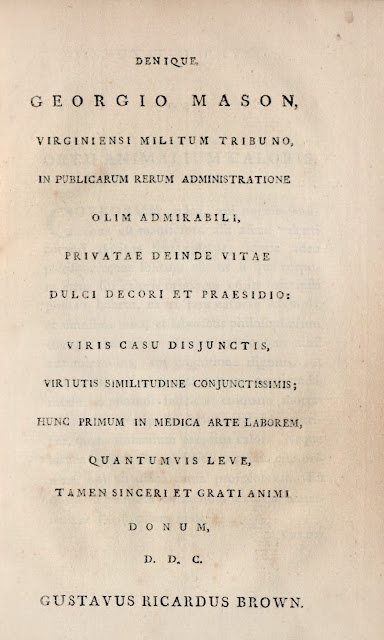I am a massive fan of auctions, having started to attend them while I lived in England and Wales. I could find china and silver there for so much less than in the US, that I attended every auction I could. When I returned to the US, much sooner than anticipated, I needed to furnish a house, so it was off to the auctions I went.
I get regular updates from the local and regional auction houses, and when two small books came up, and mentioned that they were related to early Maryland medicine, I had to check them out.
The first book is by MedChi Founder Gustavus Richard Brown. But the question is, which Gustavus Richard Brown. We have two founders with the same name, born three years apart, attending medical school in Edinburgh, and from adjoining counties. One's grandfather was the father of the other. I have a suspicion that this is the Charles County GRB.
Brown's book is titled "Disputatio Physica Inauguralis de Ortu Animalium Caloris" and it's written in Latin. The title translates as "A Physical Essay on the Rising Heat of Animals." It was published in Edinburgh in M,DCC,LXVIII. Honestly, I probably won't be reading this one.
This one of what look to be acknowledgement pages.
On the title page, there is a small poem which reads:
E tenebris tentis tam clarum extollere lumen. Qui primus potuifli, artifque arcana retesti. Te, Cullene, fequir, nostrum decus, inque uis nunc, Fixa pedum pono primis vesligia signis
Which translates as:
From the darkness, you are temped to lift up so bright a light, Who was the first to discover the secrets, I ask you? Cullene, our beauty, and now you want to. I am laying my footsteps, fixed on my feet with the first signs.
This Dr. Brown was said to have been at the bedside of George Washington when he died.
The second book was by George Fordyce, titled "Fordyce on the Digestion of Food," which, luckily, was published in English in M,DCC,XCI, so I can do a little light reading. It's about 5x8 inches and 203 pages. Both books have been re-bound.
George Fordyce was a distinguished Scottish physician, lecturer on medicine and chemist who was a Fellow of the Royal Society and the Royal College of Physicians. He was a dining eccentric, eating one meal of meat everyday at 4:00 p.m. at Dolly's Chophouse in London.
From the Epicure's Almanac (1815):
"At this house the ingenious anatomist and chemical lecturer, Dr. George Fordyce, dined every day for more than twenty years. His research in comparative anatomy had led him to conclude that man, through custom, eats oftener than nature requires, one meal a day being sufficient for that noble animal, the lion. He made the experiment on himself at this, his favorite house, and finding it succeeded, he continued the following regimen for the term above mentioned.
At four o'clock, his accustomed hour of dining, he entered, and took his seat at a table always reserved for him, on which were instantly placed a silver tankard full of strong ale; a bottle of port wine, and a measure containing a quarter pint of brandy. The moment the waiter announced him, the cook put a pound and a half of rump steak on the gridiron, and on the table a delicate trifle as a bon bouche, to serve until the steak was ready. This morsel was sometimes half a broiled chicken, sometimes a plate of fish: when he had eaten this, he took one glass of his brandy, and then proceeded to devour his steak. We say devour, because he always ate so rapidly that one might imagine that he was hurrying away to a patient, to deprive death of a dinner.
When he had finished his meat, he took the remainder of his brandy, having, during his dinner, drunk the tankard of ale, and afterwards the bottle of port. He thus daily spent an hour and a half of his time, and then returned to his house in Essex Street, to give his six-o'clock lecture on chemistry. He made no other meal until his return next day at four o'clock to Dolly's."
It is fascinating to find these relics of our earliest days.






